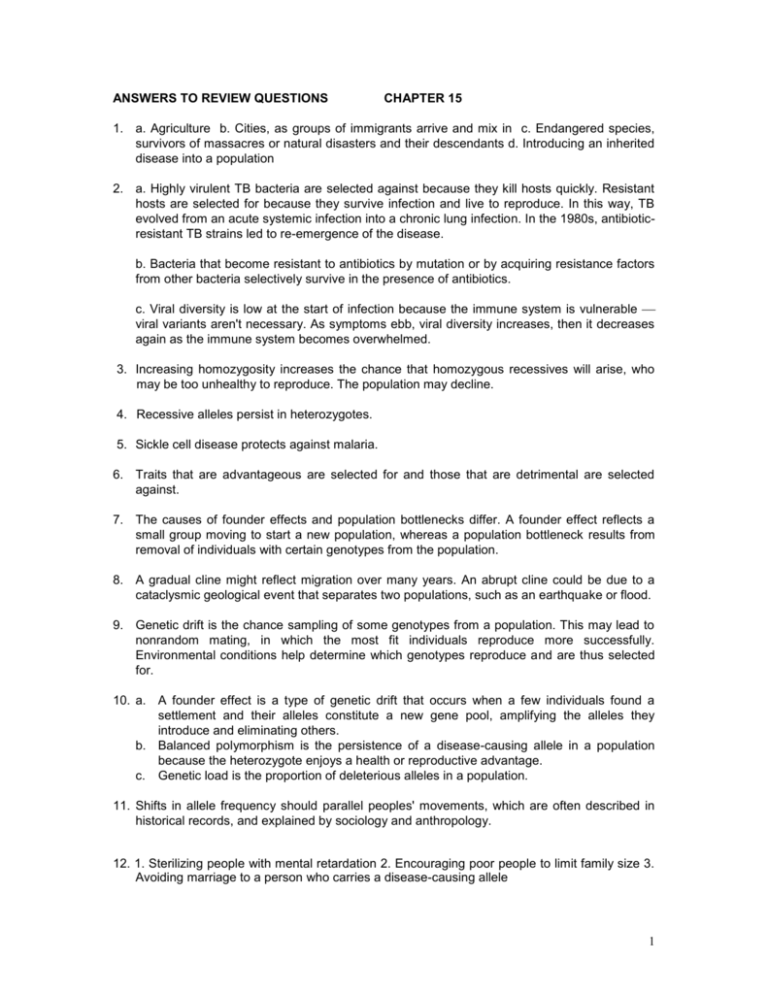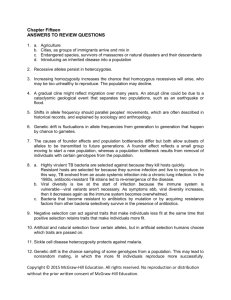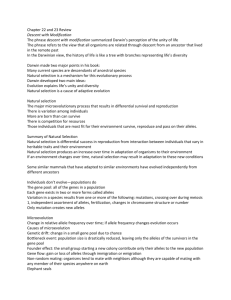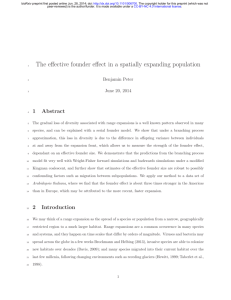ANSWERS TO REVIEW QUESTIONS
advertisement

ANSWERS TO REVIEW QUESTIONS CHAPTER 15 1. a. Agriculture b. Cities, as groups of immigrants arrive and mix in c. Endangered species, survivors of massacres or natural disasters and their descendants d. Introducing an inherited disease into a population 2. a. Highly virulent TB bacteria are selected against because they kill hosts quickly. Resistant hosts are selected for because they survive infection and live to reproduce. In this way, TB evolved from an acute systemic infection into a chronic lung infection. In the 1980s, antibioticresistant TB strains led to re-emergence of the disease. b. Bacteria that become resistant to antibiotics by mutation or by acquiring resistance factors from other bacteria selectively survive in the presence of antibiotics. c. Viral diversity is low at the start of infection because the immune system is vulnerable viral variants aren't necessary. As symptoms ebb, viral diversity increases, then it decreases again as the immune system becomes overwhelmed. 3. Increasing homozygosity increases the chance that homozygous recessives will arise, who may be too unhealthy to reproduce. The population may decline. 4. Recessive alleles persist in heterozygotes. 5. Sickle cell disease protects against malaria. 6. Traits that are advantageous are selected for and those that are detrimental are selected against. 7. The causes of founder effects and population bottlenecks differ. A founder effect reflects a small group moving to start a new population, whereas a population bottleneck results from removal of individuals with certain genotypes from the population. 8. A gradual cline might reflect migration over many years. An abrupt cline could be due to a cataclysmic geological event that separates two populations, such as an earthquake or flood. 9. Genetic drift is the chance sampling of some genotypes from a population. This may lead to nonrandom mating, in which the most fit individuals reproduce more successfully. Environmental conditions help determine which genotypes reproduce and are thus selected for. 10. a. A founder effect is a type of genetic drift that occurs when a few individuals found a settlement and their alleles constitute a new gene pool, amplifying the alleles they introduce and eliminating others. b. Balanced polymorphism is the persistence of a disease-causing allele in a population because the heterozygote enjoys a health or reproductive advantage. c. Genetic load is the proportion of deleterious alleles in a population. 11. Shifts in allele frequency should parallel peoples' movements, which are often described in historical records, and explained by sociology and anthropology. 12. 1. Sterilizing people with mental retardation 2. Encouraging poor people to limit family size 3. Avoiding marriage to a person who carries a disease-causing allele 1 13. With positive natural selection, allele frequencies shift in favor of those that increase fitness. Negative selection results in the loss of deleterious alleles from a population. Positive eugenic policies aimed to maximize the genetic contribution of those deemed acceptable or superior while negative eugenic polices were designed to minimize the contribution of those considered inferior. The major difference is that value to society is subjective and reflects the societal prejudices of the eugenicist. ANSWERS TO APPLIED QUESTIONS 1. Note: percentages may not add up to 100 because of rounding a. 23% (5/22) blue triangles, 23% (5/22) red circles, 32% (7/22) yellow squares, 23% (5/22) green diamonds. b. 31% (5/16) blue triangles, 6% (1/16) red circles, 31% (5/16) yellow squares, 31% (5/16) green diamonds c. 40% (10/25) blue triangles, 20% (5/25) red circles, 20% (5/25) yellow squares, 20% (5/25) green diamonds d. 24% (5/21) blue triangles, 24% (5/21) red circles, 29% (6/21) yellow squares, 24% (5/21) green diamonds e. 19% (3/16) blue triangles, 31% (5/16) red circles, 19% (3/16) yellow squares, 31% (5/16) green diamonds 2. Nonrandom mating 3. Removes the first mate from the gene pool, reducing the frequency of the allele for blue eyes 4. Founder effect 5. Protective alleles will be selected for and increase in frequency. 6. Tasting bitter is harmful see whether people who can taste bitter substances are overrepresented among people with cancer, because they may have avoided protective vegetables. Tasting bitter is protective see whether people who cannot taste bitter are overrepresented among those who have been poisoned. 7. Microevolution refers to changes in allele frequencies in populations. Examples: changing virulence of infectious diseases, antibiotic resistance, infectious diseases that jump species. 8. Natural selection at the time of plague epidemics 9. a. All modern Afrikaners with porphyria variegata descend from the same person in whom the disorder originated. b. One person, who had the dental disorder, contributed disproportionately to future generations. c. Heterozygotes for cystic fibrosis and sickle cell disease resist certain infectious diseases, maintaining the disease-causing allele in populations. d. The Sherpa have a variant of the hypoxia inducible factor 2 gene that enables them to tolerate low oxygen conditions. e. The Amish and Pakistani groups have high incidences of certain inherited diseases because of consanguinity. f. Migration patterns are responsible for the different frequencies of the galactokinase deficiency allele across Europe. g. Varying mtDNA sequences along the Nile river valley are due to migration. h. The alleles responsible for BRCA1 breast cancer originated in different ancestors for Ashkenazim and African-Americans. 2 10. a. Population bottleneck b. Founder effect c. Geographical barriers and natural selection, acting over time, make two populations that have different variants of inherited characteristics. d. Nonrandom mating e. Natural selection f. Population bottleneck 11. The mutations arose independently. 12. The high incidence is due to extreme consanguinity nearly everyone is related to nearly everyone else. Tracking the incidence of this condition is difficult because the symptoms exist independently, and may be caused by environmental factors rather than genes. 13. a. Balanced polymorphism b. Founder effect c. Migration d. Founder effect 14. Both will alter allele frequencies. Migration can alter the genetic structure more rapidly because the change would occur over a single generation. 15. Balanced polymorphism 16. Slavery; the Civil War; natural disasters 17. People bring dogs to new places (genetic drift). Breeding to perpetuate certain traits is artificial selection. ANSWERS TO WEB ACTIVITIES 1. Example: West Nile virus associated illness is evolving. It arrived in the U.S. in New York City in 1999 and has since spread nearly everywhere in the nation. 2. G6PD deficiency and sickle cell disease protect against malaria by altering red blood cels in ways that are unattractive to the mosquitoes that carry the pathogen. 3. Feeblemindedness. This was a subjective reflection of the societal prejudices of the eugenicists, and not necessarily a medical diagnosis. ANSWERS TO FORENSICS FOCUS 1. a. Forced sterilization b. If a trait in one family is deemed inherited, it might be assumed to be inherited in another family, when that might not be the case. c. Wealthy people seeking partners among other wealthy people d. How common the negative traits were in the general population. Whether the family members were really related biologically. Environmental influences on the traits considered. Evidence of family members without the negative traits who ANSWERS TO CASE STUDIES AND RESEARCH RESULTS 1. Anyone can get Canavan disease. 3 2. European males settled in India. Later, Asian immigrants arrived. The male European Indians had children with Asian Indian women. 3. No, because the intent would be to prevent suffering and not to improve the human race through breeding. 4








